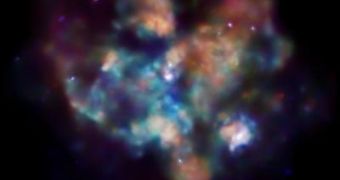The Tarantula Nebula, also known as 30 Doradus, is located approximately 160,000 light years away from our planet, in the southern constellation named Dorado, within Magellan's cloud, and it represents one of the most massive and active star forming places found in the vicinity of our galaxy. Its immense stars generate a tremendous amount of intense radiation and cause the super-fast motion of gases with a temperature of several million degrees, which determines the occurrence of large bubbles in the nearby cooler dust and gas.
The bubbles' size is further increased and lit in X-ray by the powerful supernovae explosions of the dying stars in the region. The pulsars tell the tale of their former life, as the remains of their supernovae cause the enormous dust and gas clouds to collapse and form new, young stars. This inhospitable environment at the core of the Tarantula nebula, more precisely at the junction between three such super-bubbles, is the place where the R136 star cluster lies.
This is most likely the last spawn of the nebula, with giant stars about one or two million years old. Its behemoth size is possibly due to the gas agglomeration, to which three super-bubbles contributed, that initiated the intense birth process of stars. This last picture taken by the Chandra X-ray Observatory of the Tarantula took 114,000 seconds (31 hours) of observation time to make, three times more than the longest previous exposure time.
The bright and colorful object that you see actually measures 800 light years across. If it were closer to us, like where the Orion nebula is situated – 1,300 light years away – the Tarantula formation would cover a portion of the sky equivalent to a total of 60 full moons, and its light would be sufficiently bright in order to cause shadows on the Earth's surface at night time.

 14 DAY TRIAL //
14 DAY TRIAL //